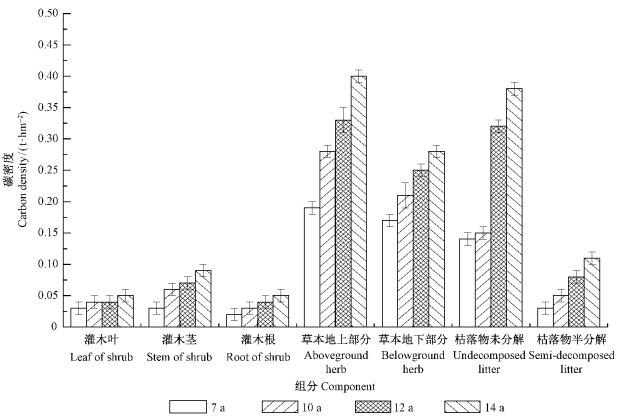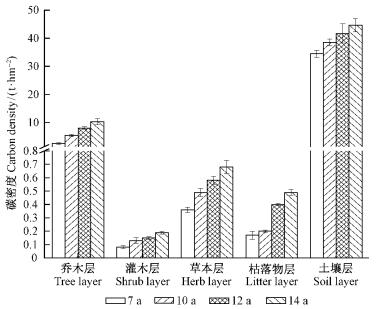文章信息
- 李彦华, 张文辉, 申家朋, 周建云, 郭有燕
- Li Yanhua, Zhang Wenhui, Shen Jiapeng, Zhou Jianyun, Guo Youyan
- 甘肃黄土丘陵区侧柏人工幼林的碳密度及分配特征
- Carbon Density and Its Allocation Characteristics of Young Plantation of Platycladus orientalis in the Hilly Loess Region of Gansu Province, China
- 林业科学, 2015, 51(6): 1-8
- Scientia Silvae Sinicae, 2015, 51(6): 1-8.
- DOI: 10.11707/j.1001-7488.20150601
-
文章历史
- 收稿日期:2014-04-14
- 修回日期:2015-04-28
-
作者相关文章
2. 青岛农业大学 青岛 266109;
3. 河西学院 张掖 734000
2. Qingdao Agricultural University Qingdao 266109;
3. Hexi College Zhangye 734000
随着大气CO2含量升高,碳汇作为缓解气候变化的有效途径之一,受到越来越多的关注(Fu et al.,2014)。森林是陆地生态系统的最大碳库,对大气CO2的吸收、固定和循环发挥着不可替代的作用(刘国华等,2000; Fang et al.,2001; 王效科等,2001; Canadell et al.,2008)。造林和再造林可有效增加森林碳汇,是陆地生态系统碳汇增加的主要途径。基于人工林在调节气候变化、发挥森林碳汇等方面的重要作用,国内外展开了大量人工林碳效益研究(Laclau,2003; Hooker et al.,2003; Specht et al.,2003; 田大伦等,2004; 尉海东等,2006; 马泽清等,2007; 吴庆标等,2008; 何斌等,2012; 刘恩等,2012; 巫涛等,2012; 王晓丽等,2013; 石洪华等,2013),但大多局限于某一林龄的人工林碳密度,而不同区域、不同树种、不同林龄人工林生态系统的碳汇功能各异。因此,研究不同区域、不同树种、不同林龄人工林生态系统碳效益对准确评价人工林生态效益具有重要意义。
黄土丘陵区退耕还林还草工程属于我国的重大生态造林工程,在改善生态环境、保持水土方面发挥了巨大作用,其碳汇效益也开始得到关注。此前,已有黄土丘陵区人工林碳密度的相关研究(王蕾等,2010; 申家朋等,2013; 刘迎春等,2011; 赵萌捷等,2013),但人工林生态系统碳密度随林龄变化的研究仍需要持续关注(刘延惠等,2012; 艾泽民等,2014)。侧柏(Platycladus orientalis)耐干旱瘠薄、适应性强,是黄土丘陵区退耕还林工程的主要造林树种之一。本研究探讨黄土丘陵区不同林龄(7,10,12和14年生)侧柏人工林生态系统碳密度及其分配格局,为估算黄土丘陵区退耕还林工程人工林生态系统的碳库及碳效益提供基础数据。
1 研究区概况研究区位于甘肃省宁县湘乐乡,是典型的黄土丘陵沟壑区(106°20′—108°45′E,35°15′—37°10′N)。海拔1 100~1 500 m,年均气温7.4℃,年降水量587.6 mm,属暖温带半干旱大陆性季风气候,土壤为典型的黄绵土。
2012年8月在研究区选择7,10,12和14年生侧柏人工林地,造林前均为坡耕地,坡度18~22°。造林设计基本相同,栽植幼苗均为2年生,株行距均为1.5 m×2 m。林下灌草稀少,主要有铁杆蒿(Artemisia sacrorum)、华北米蒿(Artemisia giraldii)、大披针苔草(Carex lanceolata)、达乌里胡枝子(Lespedeza davurica)、悬钩子(Rubus corchorifolius)、铁线莲(Clematis florida)和酸枣(Ziziphus spinosus)等。
2 研究方法 2.1 样地设置与调查根据林地立地条件相似原则,选择坡位相似,林相均一,干扰较少的7,10,12和14年生侧柏人工林样地各3块,共设置12块样地,每块样地面积均为20 m×20 m。样地林龄主要由当地造林记录和年轮样芯确定。对每块样地内树木进行每木检尺,调查胸径、树高和冠幅等指标。各林龄林分特征见表 1。
|
|
根据样地每木检尺结果,在每样地选取1株平均木,即每年龄段选出3株平均样木,4个年龄段共选出12株标准木。将标准木伐倒,采用Monsic分层切割法,地上部分测定树干、树皮、树枝各器官的鲜质量,树枝按基部直径分为细枝(<1.0 cm)和粗枝(>1.1 cm),枝、叶分开测定鲜质量; 地下部分用全挖法,将根系分为细根(根径<0.2 cm)、小根(0.2≤根径<0.5 cm)、中根(0.5≤根径<1.0 cm)、大根(1.0≤根径<2.0 cm)、粗根(根径≥2.0 cm)和根桩6类(秦武明等,2008)。地上部分和地下部分实测鲜质量并取样,带回实验室放置65℃烘箱中,烘干至恒质量,计算含水率后,将各器官的鲜质量换算成干质量。
2.2.2 林下植被生物量及枯落物现存量在每块样地设置3个5 m×5 m的灌木样方和5个1 m×1 m的草本样方,记录样方内灌木和草本的种类。采用全挖法测定地上部分和地下部分生物量,灌木分叶、枝和根3部分,草本分地上鲜质量和地下鲜质量,灌木和草本称鲜质量后分别按灌木枝、灌木叶、灌木根、草本地上和草本地下取样。在每块样地设置5个1 m×1 m枯落物样方,枯落物按未分解、半分解层称鲜质量并取样。将林下灌草及枯落物各部分样品带回实验室,放置65℃烘箱中,烘干至恒质量,计算含水率后,将鲜质量换算成干质量。根据样方调查得到林下植被生物量及枯落物现存量。
2.3 土壤样品采集在每块20 m×20 m样地内设置5个土壤采样点,按照0~10,10~20,20~30,30~50和50~100 cm共5层采样,并将同一样地内相同土层的土样混合,带回实验室待有机碳含量测定。采用环刀法测定土壤密度。
2.4 植物和土壤有机碳含量测定植物和土壤样品有机碳含量采用元素分析仪LiquiTOCⅡ(德国生产)测定。
2.5 侧柏人工林碳密度侧柏林各组分碳密度为各组分年生物量及相应有机碳含量的乘积。乔木层各器官生物量用各器官生物量与胸径、树高的关系模型来估算(马增旺等,2006;王婷等,2009;李瑞霞等,2012):
| $Y{\rm{ = }}a + b\left({{D^2}H} \right)$ |
式中:Y为各组分生物量(kg); D为胸径(cm); H为树高(m); a,b为系数。各组分生物量模型及其参数见表 2。根据侧柏各组分生物量模型,分别计算单位面积各组分生物量,各组分生物量之和即为单位面积林分生物量。
|
|
土壤碳密度计算公式(程先富等,2004)为:
| $T = 0.1 \times \Sigma {B_i} \times {C_i} \times {D_i} \times 10$。 |
式中:T为土壤有机碳密度(t·hm-2); i为土层数; Bi为i土层土壤密度(g·cm-3); Ci为i土层土壤有机碳含量(g ·kg-1); Di为i土层厚度(cm); 10为单位换算系数。
2.6 数据处理采用Excel和SPSS13.0软件对数据进行统计分析,采用单因素方差分析(one-way ANOVA)和Duncan检验比较不同林龄侧柏生态系统各组分碳含量和碳密度差异(P<0.05)。
3 结果与分析 3.1 不同林龄侧柏林碳含量 3.1.1 乔木层各器官碳含量表 3表明,侧柏各器官碳含量随着林龄增加而增大,各器官平均碳含量为447.51~513.93 g·kg-1,不同林龄间同一器官碳含量差异不显著(P>0.05),但不同器官的平均碳含量存在显著差异(P<0.05),表现为果实>树叶>树干>粗枝>细枝>细根>根桩>树皮>粗根>大根>中根>小根,以果实碳含量最高、小根碳含量最小。
|
|
表 4表明:灌木层碳含量以灌木茎最高(430.01 g·kg-1),根最低(383.28 g·kg-1); 草本层地上部分高于地下部分; 枯落物层未分解层碳含量(434.10 g·kg-1)高于半分解层碳含量(373.83 g·kg-1)。林龄对各器官或组分的碳含量影响不显著,但不同层次间碳含量差异显著(P<0.05),表现为枯落物未分解层>灌木茎>草本地上>灌木叶>灌木根>草本地下>枯落物半分解层。
|
|
表 5表明:不同林龄侧柏人工林土壤层平均碳含量为23.31~96.08 g·kg-1; 土层深度和林龄对侧柏人工林土壤碳含量均有显著影响(P<0.05); 土壤层碳含量随土层深度的增加而减小,0~10和10~20 cm土层碳含量显著高于20~30,30~50和50~100 cm土层(P<0.05); 各土层土壤碳含量均随着林龄增加而逐渐增大,0~10和10~20 cm土层增幅最明显,增幅为42.29%~72.71%。
|
|
图 1表明: 不同林龄侧柏人工林地上部分各器官均以树干碳密度最高,7,10,12和14年生侧柏树干碳密度为0.54,1.33,2.26和2.98 t·hm-2,分别占地上部分碳密度的33.13%,30.79%,34.88%和35.14%,分别占整个乔木层(包括地上部分和地下部分)的21.34%,24.58%,28.11%和28.93%; 不同林龄侧柏人工林地下部分各器官均以根桩碳密度最高,7,10,12和14年生侧柏根桩碳密度为0.45,0.53,0.93和1.23 t·hm-2,分别占地下部分碳密度的50%,48.62%,59.62%和67.58%,分别占整个乔木层(包括地上部分和地下部分)的17.79%,9.80%,11.57%和11.94%。侧柏各器官碳密度随林龄变化存在显著差异(P<0.05)。
 |
图 1 不同林龄侧柏人工林各器官碳密度 Fig. 1 Carbon density of different organs of different aged P. orientalis plantations |
图 2表明:侧柏林下灌木层各器官、草本层各组分和枯落物层各组分碳密度均存在显著差异(P<0.05),随林龄增加呈现增大的趋势。灌木各器官中以茎碳密度最高,7,10,12和14年生侧柏林下灌木茎碳密度分别为0.03,0.06,0.07和0.08 t·hm-2,分别占灌木层碳密度的37.50%,46.15%,46.67%和47.37%。草本层地上部分碳密度大于地下部分,7,10,12和14年生侧柏林下草本层地上部分碳密度分别为0.17,0.28,0.35和0.36 t·hm-2,分别占草本层碳密度的52.78%,57.14%,56.90%和58.82%。枯落物未分解层碳密度大于半分解层,7,10,12和14年生侧柏林下枯落物未分解层碳密度分别为0.11,0.15,0.32和0.44 t·hm-2,分别占枯落物层碳密度的82.35%,75.00%,80.00%和77.55%。
 |
图 2 侧柏人工林林下灌木、草本和枯落物层碳密度 Fig. 2 Carbon density of shrub,herb and litter of Platycladus orientalis plantations |
图 3表明:侧柏人工林0~100 cm土层的碳密度随着林龄增加而增大,且差异显著(P<0.05)。其中0~10和50~100 cm土层碳密度明显高于其他土层; 7,10,12和14年生侧柏人工林0~10 cm土层碳密度为6.3,8.27,10.25和11.48 t·hm-2,分别占整个土壤层(0~100 cm)的18.30%,21.51%,24.58%和25.69%,50~100 cm土壤层碳密度为15.46,15.64,16.21和16.71 t·hm-2,分别占整个土壤层(0~100 cm)的44.92%,40.69%,38.87%和37.40%。
 |
图 3 侧柏人工林土壤层碳密度 Fig. 3 Carbon density of soil layer of P. orientalis plantations |
图 4表明:不同林龄侧柏人工林生态系统碳密度均以土壤层和乔木层为主要碳库; 7,10,12和14年生侧柏林土壤层碳密度分别为34.42,38.44,41.70和44.68 t·hm-2,分别占侧柏人工林生态系统碳密度的91.64%,86.05%,81.97%和79.30%; 7,10,12和14年生侧柏林乔木层碳密度分别为2.53,5.41,8.04和10.30 t·hm-2,分别占侧柏人工林生态系统碳密度的6.74%,12.11%,15.80%,18.28%; 而灌木层、草本层和枯落物层的碳密度之和所占比例小于5%。随着林龄增加,土壤层碳密度占侧柏人工林生态系统碳密度的比例减少了13.46%; 而乔木层碳密度占侧柏人工林生态系统碳密度的分配比例增加了171.21%,由于乔木层生物量积累增多,导致碳密度增加幅度明显。乔木层、灌木层、草本层、枯落物层和土壤层碳密度均随着林龄的增加而增大,且不同层次碳密度受林龄影响差异显著(P<0.05)。
 |
图 4 侧柏人工林生态系统碳密度及其分配特征 Fig. 4 Carbon density and its allocation characteristics of P. orientalis plantations ecosystem |
本研究中,黄土丘陵区不同林龄侧柏人工幼林的乔木层各器官平均碳含量为447.51~513.93 g·kg-1,且差异显著(P<0.05),不同林龄间相同器官碳含量大小不同,但差异不显著(P>0.05),本研究中侧柏人工林乔木层碳含量与国内外研究中所用森林碳系数(0.4~0.5)(刘恩等,2012)基本一致。各器官平均碳含量为474.46 g·kg-1,低于陕西千阳侧柏人工林各器官平均碳含量(王蕾等,2010),高于徐州侧柏各器官平均碳含量(李瑞霞等,2012),说明侧柏生长区域的差异在一定程度上影响到乔木层碳含量的差异。7,10,12和14年生侧柏人工林各器官平均碳含量表现为果实>树叶>树干>粗枝>细枝>细根>根桩>树皮>粗根>大根>中根>小根。
林下植被及枯落物层碳含量均低于乔木层各器官碳含量,且灌木层、草本层地上部分碳含量均高于地下部分碳含量。而枯落物未分解层碳含量高于半分解层碳含量,可能与枯落物层部分有机质被分解有关(Lal,2005)。土壤层碳含量大小受到造林年限(Song et al.,2003; Zinn et al.,2002)、微生物代谢(何志斌等,2006)和地表枯落物分解程度(Lal,2005)等的影响。本研究中,不同林龄侧柏人工林土壤碳含量随林龄增加而增大,随土壤深度增加而降低。表层0~10 cm土壤碳含量受林龄影响最大,随林龄增加而增幅显著(P>0.05)。
黄土丘陵区7,10,12和14年生侧柏人工林生态系统的碳密度分别为37.56,44.67,50.87和56.34 t·hm-2,不同林龄侧柏人工林生态系统碳密度分配格局均表现为土壤层>乔木层>草本层>枯落物层>灌木层,土壤层和乔木层是侧柏人工林生态系统主要的碳库。侧柏人工林乔木层碳密度随着林龄增加增幅较大,其中,树干贡献率最大,不同林龄侧柏人工林树干均是乔木层碳库的主体。本研究中14年生侧柏人工林乔木层碳密度(10.3 t·hm-2)低于湖南会同11年生杉木林(Cunninghamia lanceolata)乔木层碳密度(44.76 t·hm-2)(方晰等,2002)和我国森林植被平均碳密度(57.07 t·hm-2)(周玉荣等,2000)。枯落物层虽是侧柏人工林生态系统中较小的碳库,但却是增加土壤碳汇的重要途径(艾泽民等,2014)。侧柏人工林土壤碳密度随着林龄增加而增大,14年生侧柏人工林土壤碳密度(44.68 t·hm-2)低于徐州40年生侧柏林(60.67 t·hm-2)(李瑞霞等,2013),同时低于我国森林平均土壤碳密度(193.55 t·hm-2)(周玉荣等,2000),这可能是黄土丘陵区水热条件差、水土流失造成的,在人工林经营中应重视土壤碳库的保护。黄土丘陵区侧柏人工林处于幼龄林阶段,仍低于我国森林生态系统平均碳密度,但随着林龄的增加,其碳汇能力将会逐渐增大,其发育阶段后期碳汇能力仍有待于进一步研究。
| [1] |
艾泽民,陈云明,曹扬.2014.黄土丘陵区不同林龄刺槐人工林碳、氮储量及分配格局.应用生态学报,25(2): 333-341. (Ai Z M, Chen Y M, Cao Y, et al.2014. Storage and allocation of carbon and nitrogen in Robinia pseudoacacia plantation at different ages in the loess hilly region, China. Chinese Journal of Applied Ecology, 25(2): 333-341[in Chinese]).(  2) 2)
|
| [2] |
程先富,史学正,于东升,等.2004.兴国县森林土壤有机碳库及其与环境因子的关系.地理研究,23(2): 211-217. (Cheng X F, Shi X Z, Yu D S, et al. 2004. Organic carbon pool of forest soil and its relationship to environment factors in Xingguo county of Jiangxi Province. Journal of Geographical Research, 23(2) : 211-217[in Chinese]).(  1) 1)
|
| [3] |
方晰,田大伦,项文化.2002.速生阶段杉木人工林碳素密度、贮量和分布.林业科学,38(3): 14-19. (Fang X, Tian D L, Xiang W H, et al. 2002. Density,storage and distribution of carbon Chinese fir plantaion at fast growing stage. Scientia Silvae Sinicae, 38(3): 14-19[in Chinese]).(  1) 1)
|
| [4] |
何斌,刘红英,余春和.2012.黑木相思人工林生态系统生物量、碳贮量及其分配特征.东北林业大学学报,40(3): 48-50,71. (He B, Liu H Y, Yu C H, et al. 2012. Vertical distribution of biomass and carbon storage in Acacia melanoxylon plantation ecosystem. Journal of Northeast Forestry University, 40(3): 48-50,71[in Chinese]).(  1) 1)
|
| [5] |
何志斌,赵文智,刘鹄,等.2006.祁连山青海云杉林斑表层土壤有机碳特征及其影响因素.生态学报,26(8): 2572-2577. (He Z B, Zhao W Z, Liu H, et al.2006. Characteristic of Picea crassifolia forest soil organic carbon and relationship with environment factors in the Qilian mountain. Acta Ecologica Sinica, 26(8): 2572-2577[in Chinese]).(  1) 1)
|
| [6] |
李瑞霞,郝俊鹏,闵建刚,等.2012.不同密度侧柏人工林碳储量变化及其机理初探.生态环境学报,21(8): 1392-1397. (Liu R X, Hao J P, Min J G, et al.2012. Carbon storage changes and its mechanism of different densities in Platycladus orientalis plantation.Ecology and Environmental Sciences, 21(8): 1392-1397[in Chinese]).(  2) 2)
|
| [7] |
刘恩,王晖,刘世荣. 2012.南亚热带不同林龄红锥人工林碳贮量与碳固定特征.应用生态学报,23(2): 335-340. (Liu E, Wang H, Liu S R, et al.2012.Characteristics of carbon storage and sequestration in different age beech(Castanopsis hystrix) plantations in south subtropical area of China. Chinese Journal of Applied Ecology, 23(2): 335-340[in Chinese]).(  2) 2)
|
| [8] |
刘国华,傅伯杰,方精云.2000.中国森林碳动态及其对全球碳平衡的贡献.生态学报,20(5): 733-740. (Liu G H, Fu B J, Fang J Y, et al. 2000. Carbon dynamics of Chinese forests and its contribution to global carbon balance. Acta Ecologica Sinica, 20(5): 733-740[in Chinese]).(  1) 1)
|
| [9] |
刘延惠,王彦辉,于澎涛,等, 2012.六盘山南部华北落叶松人工林土壤有机碳含量.林业科学,12(12):1-9. (Liu Y H, Wang Y H, Yu P T, et al. 2012.Soil organic carbon contents of Larix principis-rupprechtii plantations in the southern part of Liupan mountains, Scientia Silvae Sinicae, 12(12): 1-9[in Chinese]).(  1) 1)
|
| [10] |
刘迎春,王秋凤,于贵瑞,等.2011.黄土丘陵区两种主要退耕还林树种生态系统碳储量和固碳潜力.生态学报, 31(15): 4277-4286. (Liu Y C, Wang Q F,Yu G R, et al. 2011. Ecosystems carbon storage and carbon sequestration potential of two main tree species for the grain for green project on China's hilly Loess Plateau.Acta Ecologica Sinica, 31(15) : 4277-4286[in Chinese]).(  1) 1)
|
| [11] |
马泽清,刘琪璟,徐雯佳,等.2007.江西千烟洲人工林生态系统的碳蓄积特征.林业科学,43(11): 1-7. (Ma Z Q, Liu Q J, Xu W J,et al. 2007. Carbon storage of artificial forest in Qianyanzhou,Jiangxi Province. Scientia Silvae Sinicae, 43(11): 1-7[in Chinese]).(  1) 1)
|
| [12] |
马增旺,毕君,孟祥书,等.2006.人工侧柏林单株生物量研究.河北林业科技,(3): 1-3. (Ma Z W, Bi J, Meng X S, et al. 2006.The biomass research of individual in Platycladus orientalis plantation. The Journal of Hebei Forestry Science and Technology, (3): 1-3[in Chinese]).(  1) 1)
|
| [13] |
秦武明,何斌,韦善华,等. 2008.厚荚相思人工幼林生态系统碳储量及其分布研究.安徽农业科学,36 (32): 14089-14092. (Qin W M, He B,Wei S H, et al. 2008. Study on carbon storage and distribution of Acacia crassicarpa young plantation ecosystem. Journal of Anhui Agricultural Sciences, 36(32): 14089-14092[in Chinese]).(  1) 1)
|
| [14] |
石洪华,王晓丽,王嫒,等.2013.北长山岛森林乔木层碳储量及其影响因子.生态学报,33(19): 6363-6372. (Shi H H, Wang X L, Wang A, et al. 2013.Storage and drivers of forests carbon on the beichangshan island of miaodao archipelago. Acta Ecologica Sinica, 33(19): 6363-6372[in Chinese]).(  1) 1)
|
| [15] |
申家朋,张文辉,李彦华,等.2013.黄土高原丘陵区退耕还林地油松人工林碳储量及分配特征研究.西北植物学报,33(11): 2309-2316. (Shen J P, Zhang W H, Li Y H, et al. 2013. Characteristics of carbon storage and sequestration of Pinus tabulaeformis forest land converted by farmland in the hilly Loess hilly area. Acta Botanica Boreali-Occidentalia Sinica , 33(11): 2309-2316[in Chinese]).(  1) 1)
|
| [16] |
田大伦,方晰,项文化. 2004.湖南会同杉木人工林生态系统碳素密度.生态学报,24 (11): 2382-2386. (Tian D L, Fang X, Xiang W H, et al. 2004. Carbon density of the Chinese fir plantation ecosystem at Huitong, Hunan Province. Acta Ecologica Sinica, 24 (11): 2382-2386[in Chinese]).(  1) 1)
|
| [17] |
王蕾,张景群,王晓芳,等.2010.黄土高原两种人工林幼林生态系统碳汇能力评价.东北林业大学学报,38(7): 75-78. (Wang L, Zhang J Q,Wang X F, et al. 2010.Carbon sink in two young plantations in Loess Plateau. Journal of Northeast Forestry Univesity, 38(7): 75-78[in Chinese]).(  2) 2)
|
| [18] |
王婷,袁志良,叶永忠,等.2009.嵩山国家森林公园不同年龄侧柏人工林生物量初步研究.河南科学,27(7): 817-820. (Wang T, Yuan Z L, Ye Y Z, et al. 2009. Primary study on biomass of Platycladus orientalis plantation at different age stands in the Songshan mountains national forest park. Henan Science, 27(7): 817-820[in Chinese]).(  1) 1)
|
| [19] |
王效科,冯宗炜,欧阳志云.2001.中国森林生态系统的植物碳储量和碳密度研究.应用生态学报,12(1): 13-16. (Wang X K, Feng Z W, O Z Y, et al. 2001. Vegetation carbon storage and density of forest ecosystems in China. Chinese Journal of Applied Ecology, 12(1): 13-16[in Chinese]).(  1) 1)
|
| [20] |
王晓丽,王嫒,石洪华,等.2013.山东省长岛县南长山岛黑松和刺槐人工林的碳储量. 应用生态学报,24(5): 1263-1268. (Wang X L, Wang A, Shi H H, et al. 2013. Carbon storage of Pinus thunbergii and Robinia pseudoacacia plantations on Nanchangshan island, Changdao county of Shandong Province. Chinese Journal of Applied Ecology, 24(5): 1263-1268[in Chinese]).(  1) 1)
|
| [21] |
尉海东,马祥庆.2006.不同发育阶段楠木人工林生态系统碳贮量研究.烟台师范学院学报:自然科学版,22(2): 130-133. (Wei H D, Ma X Q. 2006.Study on the carbon storage and distribution of Phoebe bourmei plantation ecosystem of different growing stages.Yantai Normal University Journal:Natural Science, 22(2): 130-133[in Chinese]).(  1) 1)
|
| [22] |
巫涛,彭重华,田大伦,等.2012.长沙市区马尾松人工林生态系统碳储量及其空间分布.生态学报, 32(13): 4034-4042. (Wu T, Peng Z h, Tian D L, et al. 2012. Spatial distribution of carbon storage in a 13-year-old Pinus massoniana forest ecosystem in Changsha City. Acta Ecologica Sinica, 32(13): 4034-4042[in Chinese]).(  1) 1)
|
| [23] |
吴庆标,王效科,段晓男,等.2008.中国森林生态系统植被固碳现状和潜力. 生态学报, 28(2): 517-524. (Wu Q B, Wang X K, Duan X N, et al. 2008. Carbon sequestration and its potential by forest ecosystems in China. Acta Ecologica Sinica, 28(2): 517-524[in Chinese]).(  1) 1)
|
| [24] |
赵萌捷,陈云明,艾泽民,等.2013.黄土丘陵区典型人工林有机碳分布特征及其影响因素.水土保持通报,33(2): 270-275. (Zhao M J, Chen Y M, Ai Z M, et al. 2013. Distribution characteristics of soil organic carbon and their affecting factors of typical plantations in loess hilly region.Bulletin of Soil and Water Conservation, 33(2): 270-275[in Chinese]).(  1) 1)
|
| [25] |
周玉荣,于振良,赵士洞.2000.我国主要森林生态系统碳贮量和碳平衡.植物生态学报,24(5): 518-522. (Zhou Y R, Yu Z L, Zhao S D, et al. 2000.Carbon storage and budget of major Chinese forest types. Acta Phytoecologica Sinica, 24(5): 518-522[in Chinese]).(  2) 2)
|
| [26] |
Canadell J G, Raupach M R.2008.Managing forests for climate change mitigation. Science,320 (5882): 1456-1457.( 1) 1)
|
| [27] |
Fang J Y, Chen A P,Peng C H,et al.2001.Changes in forest biomass carbon storage in China between 1949 and 1998.Scinece, 292 (5525): 2320-2322.( 1) 1)
|
| [28] |
Fu W J, Jiang P K,Zhao K L, et al.2014.The carbon storage in moso bamboo plantion and its spatial variation in Anji County of southeastern China. Soil Sediments,14 (2): 320-329.( 1) 1)
|
| [29] |
Hooker T D, Compton J E. 2003.Forest ecosystem carbon and nitrogen accumulation during the first century after agricultural abandonment.Ecological Applications, 13 (2): 299-313.( 1) 1)
|
| [30] |
Laclau P.2003. Biomass and carbon sequestration of ponderosa pine plantations and native cypress forests in northwest Patagonia. Forest Ecology and Management, 180 (1-3): 317-333.( 1) 1)
|
| [31] |
Lal R.2005.Forest soils and carbon sequestration.Forest Ecology and Management,220(1): 242-258.( 2) 2)
|
| [32] |
Song C H,Woodcock C E.2003.A regional forest ecosystem carbon budget model: impacts of forest age structure and landuse history.Ecological Modeling, 164 (1): 33-47.( 1) 1)
|
| [33] |
Specht A,West P W.2003.Estimation of biomass and sequestered carbon on farm forest plantations in northern New South Wales.Australia. Biomass and Bioenergy, 25(4): 363-379.( 1) 1)
|
| [34] |
Zinn Y L,Dimas V S,Resck J E, et al.2002.Soil organic carbon as affected by afforestation with Eucalyptus and Pinus in the Cerrado region of Brazil. Forest Ecology and Management, 166(1-3): 285-294.( 1) 1)
|
 2015, Vol. 51
2015, Vol. 51
